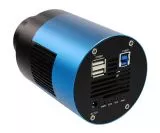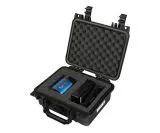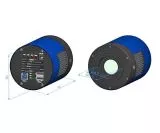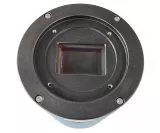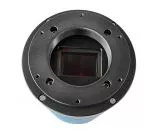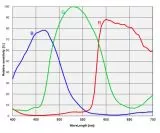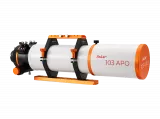- Details
- Mehr Bilder
Produktbeschreibung
TS-Optics ToupTek MONO Astrokamera 2600MP G2 Sony IMX571 Sensor D=28,3 mm
Gekühlte USB 3.0 APS-C MONO Astrokamera mit leistungsstarken Sony CMOS Sensor für Astrofotografie Gen. 2 mit Adapterflansch
♦ Leistungsstarke zweistufige Peltierkühlung bis 35 °C unter Umbgebungstemperatur
♦ Sony IMX571 APS-C Format s/w Sensor- back-illuminated
♦ Hohe Auflösung durch 3,76 µm Pixel
♦ 16 bit ADC - Dynamikumfang wie ein CCD Sensor
♦ kein Verstärkerglühen mehr durch Zero-Ampglow-Schaltung
♦ Teleskopseitiger Anschluss: M42x0,75 Innengewinde
♦ Arbeitsabstand nur 17,5 mm ab dem T2 (M42x0,75) Innengewinde
♦ Eingebauter AR-Schutzfilter mit IR Durchlass
♦ Heizung des optischen Fensters gegen Taubeschlag - in vier Stufen einstellbar
♦ DDR3 Buffer 512 MB für eine stabilere Datenübertragung
♦ Binning wird unterstützt
♦ Treiber und Anleitung sind online erhältlich (siehe Link)
♦ G2: die Kameras kommen mit abnehmbaren T2 Anschluss. Der Abstand von der Aufnahmefläche für den Flansch zum Sensor beträgt 8,8 mm
TS 2600MP MONO-Astrokamera der neuesten Generation
Die Kamera mit dem leistungsstarken Sony IMX571-Sensor ermöglicht Astrofotografie auf sehr hohem Niveau. Dieser gekühlte CMOS-Sensor hat kein Verstärkerglühen mehr und kann für alle Bereiche der Astrofotografie verwendet werden. Durch die hohe Auflösung des Sensors werden bereits feine Details auch bei kürzeren Brennweiten dargestellt.Ein weiterer Vorteil ist die sensationelle Lichtempfindlichkeit. Die QE von 91 % durch die BACK ILLUMINATION Technologie ermöglichen bereits tiefe Astroaufnahmen mit kurzen Belichtungszeiten. Dadurch wird die Kamera für Deep-Sky-Fotografie sehr gut geeignet.
Gen. 2 Lieferung mit abnehmbaren T2 Adapter
Um die Kamera noch flexibler zu machen, ist der T2 Anschluss bei der Kamera abnehmbar. Der Arbeitsabstand von 17,5 mm bleibt aufrecht.♦ optisch wirksamer Weg des Adapters ist 8,7 mm - Auflagemaß der Kamera ohne dem T2 Adapter ist also 8,8 mm.
♦ Befestigung des Adapters an der Kamera mit 4x M2,5 Schrauben - Abstand der Innengewinde von der Mitte aus 26,5 mm
♦ Durchmesser des Adapters ist 59 mm
♦ Der Adapter kann mit optionalen M2,5 Madenschrauben auch als Tilting Adapter eingesetzt werden.
Back-Illumination Technologie:
Der rückseitenbelichtete CMOS-Bildsensor von Sony verbessert die Empfindlichkeit und die Rauschunterdrückung - die Schlüsselfaktoren für die Verbesserung der Bildqualität - durch die Verlagerung der grundlegenden Pixelstruktur von der Vorder- zur Rückseitenbelichtung. Die Vorteile der CMOS-Bildsensoren, wie geringer Stromverbrauch und hohe Betriebsgeschwindigkeit, wurden beibehalten.Die Rückseitenbelichtung verbessert die Lichtaufnahme und erhöht gleichzeitig die Lichtmenge. Damit werden deutlich kürzere Belichtungszeiten möglich und das führt zu einer verbesserten Quanteneffizienz von 91 %.
Sony hat eine einzigartige Fotodiodenstruktur und eine On-Chip-Linse entwickelt, die für rückseitenbelichtete Strukturen optimiert ist, das ergibt eine höhere Empfindlichkeit und ein geringeres Zufallsrauschen ohne Licht, indem es Rauschen, Dunkelstrom und defekte Pixel im Vergleich zur herkömmlichen vorderseitig belichteten Struktur reduziert.
Kein Verstärkerglühen:
Herkömmliche CMOS-Sensoren erzeugen während des Betriebs eine schwache Infrarot-Lichtquelle, die in den Ecken unkalibrierter Bilder oft als verräterische Anzeichen für das "Glühen des Verstärkers" zu sehen ist. Da der Sensor dieser Kamera eine Zero-Ampglow-Schaltung verwendet, müssen Sie sich auch bei der Verwendung von hochverstärkten, lang belichteten Bildern keine Sorgen über das "Amp-Glow" (Verstärkerglühen) machen.Anschluss an Korrektoren mit M48-Gewinde und 55 mm Arbeitsabstand mit FilterwechselDie meisten Komakorrektoren oder Field-Flattener für Refraktoren haben 55 mm Arbeitsabstand und an der Kameraseite ein M48x0,75-Gewinde. Hier finden Sie einen interessanten Vorschlag für den Anschluss. Die Kamera hat ein Auflagemaß von 17,5 mm ab dem T2-Innengewinde. Die Adapter sind von der Kamera zum Korrektor:
1. TSFSLM48T2 - Filterschublade mit T2-Anschluss an der Kameraseite und M48-Gewinde an der Teleskopseite.
2. TSVF220 - 20-mm-M48-Verlängerung
Gesamt 55,5 mm Auflagemaß - die 0,5 mm gleichen gut den Glasweg des Filters aus - Punktlandung!!
| Sensor: | CMOS SW Sensor IMX571 |
| Größe: | 23.5 x 15,7 mm - Diagonale 28,3 mm |
| Pixelgröße: | 3,8 µm |
| Pixelanzahl: | 6224 x 4168 - 26 MP |
| Bit Tiefe: | 16 |
| Bilder pro Sekunde: | 7 Bilder bei voller Auflösung |
| Kühlung: | Peltierkühlung bis 35 °C unter Umgebungstemperatur |
| Stromversorgung: | 12 V, 3 A |
| Stromanschluss: | 5,5/2,1 mm Hohlsteckerbuchse |
| Schnittstellen: | USB 3.0 und USB 2.0 |
| Unterstützte Betriebssysteme: | Windows ab XP |
| Abmessungen: | Durchmesser 80 mm - Länge 100 mm |
| Anschluss Teleskopseite: | T2 Innengewinde (M42x0,75) |
| Auflagemaß: | 17,5 mm (Abstand Sensor bis Innengewinde) |
♦ Kamera
♦ Staubschutzkappe (auf Kamera)
♦ Teleskopadapter
♦ Netzteil mit Netzkabel
♦ USB 3.0 High-Speed Kabel - Länge 1,5 Meter
♦ Trockenmittel
♦ USB Stick mit Software
♦ Zettel mit QR Code und Weblink
♦ Transportkoffer
Diesen Artikel haben wir am 20.11.2023 in unseren Katalog aufgenommen.
Profitieren Sie von unseren Erfahrungen als Teleskop-Spezialisten:
denn sehen heißt verstehen
in besonderen Fällen auch Vor-Ort-Service im Raum München

